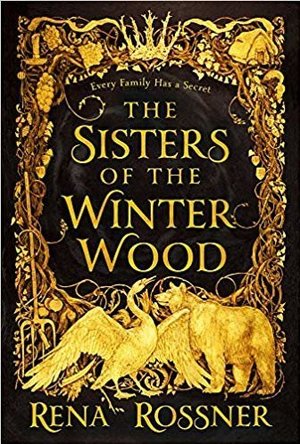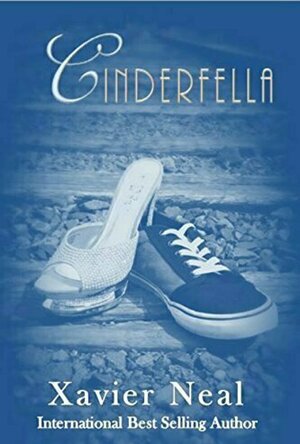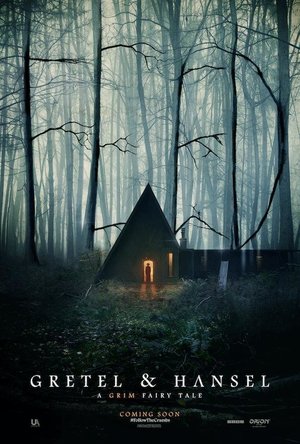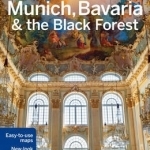
Lonely Planet Munich, Bavaria & the Black Forest
Lonely Planet, Marc Di Duca and Kerry Christiani
Book
Lonely Planet: The world's leading travel guide publisher Lonely Planet Munich, Bavaria & the Black...
Eleanor Luhar (47 KP) rated The Sisters of the Winter Wood in Books
Jun 24, 2019
This book is set in Dubossary, narrated alternately by Liba and Laya. Liba is the older of the two, the only children in their family. They are Jews, and while this book was hugely about their faith and discrimination against them, it is not only about that. This book was like a new fairytale. It had magic in every page, and was genuinely exciting to read. There were tragic elements, tons of romance, and even a sense of suspense.
The girls are left in their home alone when their parents rush off to Kupel in a family emergency. But just as they plan to leave, the girls' Mami decides it's time to tell her daughters who they really are: a bear and a swan.
As I said, I will not delve into the story too much. But I really loved the story involving Laya and the Hovlin brothers, as well as Liba's own internal struggles. Laya's romance at the end of the book was, in my opinion, a little rushed and unexpected, but that's the only real downside I have.
The writing was lovely - it included Yiddish and Hebrew dialect, which was translated in the Author's Note at the end. (A quick side note; I actually read the entire Note, which is really quite rare for me.) And Laya's account, in particular, felt so poetic. She was definitely my favourite character, as much as I love Liba, too. And the relationship between the girls is so, so lovely. No matter how much they try to push each other away, they are always there for each other in the end.
As I enjoyed this book so much, I tried to talk about it with my boyfriend. However, I soon discovered that describing this story is really quite a feat. It was full of little details and twists that just made the story.
I really liked this book. As I only received an ARC and not a final edition, I didn't have the official layout, which I can imagine may add to it also. Even so, I'm easily giving this 4.5 to 5 stars.
When Broadway Went to Hollywood
Book
The Wizard of Oz, Gigi, Top Hat, High Society - some of the most popular movie musicals ever made...
Lottie disney bookworm (1056 KP) rated Dragon By Midnight in Books
Aug 30, 2021
Karen Kincy had some bestseller-worthy ideas when it came to this book: I loved Sikandar's mysterious sorcerer vibe and dark past; the Jinni gave Arabian nights/Aladdin vibes and the plot twist of the curse was brilliant.
However, in my opinion, the major elements that made Dragon by Midnight great were just not developed enough and I was left with unanswered questions, in particular with Cinderella's story line.
Sikandar is bound to be everyone's favourite character and the description of him as a cinnamon roll hero is perfect. I would have liked him to keep his mystery for a bit longer and for the worthiness of his previous actions to be withheld instead of instantly revealed - it felt like he was a mysterious murderer one second and then an amazing hero the next . Although this was in keeping with the fast-paced nature of the story.
Similarly, the romance between Sikandar and Cinderella developed so quickly. She almost fell in love with him straight away! It was also very fluffy and cute: which is not a criticism! This is a YA book after all. However, sometimes Cinderella seemed too wrapped up in the cute boy and less concerned about ... well, being a dragon!
Prince Benedict Charming was brilliant in his arrogance and cringe worthiness. I did expect a bit more action and dragon-hunting from him though and his attitude towards Cinderella when she returned to the castle as a girl was very odd. I truly couldn't tell if he was so self-absorbed he didn't care what had happened, or if he was plotting something.
Overall I did enjoy Dragon by Midnight and read it within a day. It is a very cute, fast-paced fairytale with some genius ideas. The overly descriptive language and lack of character development would push it closer to the middle-grade side of YA for me but I enjoyed the story and will possibly pick up the sequel if I see it.
I received an advance review copy for free, and I am leaving this review voluntarily.
Merissa (13524 KP) rated Cinderfella in Books
Apr 12, 2023
This story shows you that you cannot judge by what you think you know. Everyone lives behind a mask of some form or another. What may look like a privileged life may be anything but that. This is a lesson that Connor has to learn, along with others, if he is going to make a go of his life.
I loved that the book was written from the male's perspective and I also loved the fact that they didn't just jump straight into bed. How this was written made the growth of their relationship all the more special and all the more heartbreaking when it didn't work the way you wanted it to.
There were a couple of things that didn't sit right for me which is why I've given 4 stars, but to be fair, I can't actually think of a different way to do it either. I loved that they were putting on a show and it was pressured, but the idea of him wanting to be an actor just didn't feel right.
This is a feel-good story with a twist on the classic fairytale (obviously) but still manages to stand on its own feet. Definitely recommended for all fans of YA/NA Contemporary.
* A copy of this book was provided to me with no requirements for a review. I voluntarily read this book; the comments here are my honest opinion. *
Merissa
Archaeolibrarian - I Dig Good Books!
August 13, 2016
ClareR (6037 KP) rated The Inheritance Games in Books
Sep 8, 2020
Avery Grambs wants more from her life than living hand to mouth, as she seems to be doing with her sister. Her mother has died, she has no contact with her father. She decides that the best way to change her life is to get a good education at a very good college, with the help of a scholarship. Indeed, she does seem to be very clever.
And then a young man comes to her school, and tells her that she has inherited some of the fortune of Tobias Hawthorne - a man she has never met and knows nothing about. In order to keep her inheritance and deprive the rest of the Hawthornes from getting their hands on the money, Avery has to live for a year in the Hawthorne mansion. Sounds easy, but it’s not. It’s a sprawling, maze-like place, with secret corridors and countless rooms. And the Hawthorne grandsons, on the whole, don’t seem to be hugely keen on her living with them, and neither does their mother.
No-one, including Avery, can understand why she should inherit the Hawthorne fortune. Tobias Hawthorne has one last Rick up his sleeve - a treasure hunt of sorts, that he set before his death for his grandsons and Avery. Just the thing to bring them together - or is it?
I thoroughly enjoyed this. Yes, it’s a bit far-fetched, but who hasn’t wanted to become the equivalent of a billionaire? To never need to worry about money? To have the house version of the Tardis?! This last bit, actually, would totally do it for me - as long as I could cleaners!
I think this will be the first in a trilogy, and I have a sneaking suspicion that I’ll be reading the next one. YA isn’t just for the kids, you know!
Many thanks to the Pigeonhole for making sure I read another one of my NetGalley books, and the publisher for an ebook copy.
Neon's Nerd Nexus (360 KP) rated Gretel & Hansel (2020) in Movies
Sep 10, 2020

Mimpi Dreams
Games and Entertainment
App
50% off for a limited time as part of the App Store’s Children’s Day promotion! Selected by The...
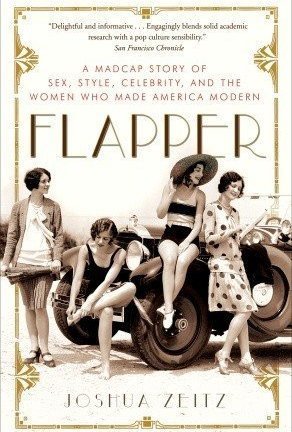
Flapper: A Madcap Story of Sex, Style, Celebrity, and the Women Who Made America Modern
Book
Blithely flinging aside the Victorian manners that kept her disapproving mother corseted, the New...
1920s
Lottie disney bookworm (1056 KP) rated She Who Became The Sun in Books
Aug 30, 2021
After a fortune teller destines her brother for greatness and her own life to be worthless, a peasant girl may be expected to resign herself to her fate. However, upon her brother’s premature death, the girl seizes an opportunity to adopt both his name and his destiny.
She Who Became the Sun is a brutal, hard hitting debut to The Radiant Emperor series. Comparisons tend to quote Mulan due to the setting and the nature of Zhu disguising her female birth, but this is honestly where the comparison ends. For me, this novel is as if Mulan was in the Game of Thrones novels: warring factions, political backstabbing and the quest for power, Parker-Chan really doesn’t hold back.
As the debut novel, She Who Became the Sun has a lot of work to do in world-building and revealing the history behind the main characters. As a result, the pace of writing can feel a little slow at times but the final few chapters are well worth any previous perseverance.
Despite the pace in the middle of the novel, Parker-Chan’s writing is lyrical and intense simultaneously. Zhu’s desire to live gives a desperate, raw undertone to every one of the chapters under her POV. This is in direct juxtaposition from our other main character, Ouyang, who exudes cold detachment.
Zhu and Ouyang are both orphans, both queer and, as a girl and a eunuch, are both shunned by society. However, they consistently find themselves facing each other on opposite sides of a war: they may be ‘like and like’ but they are both characters who believe that their path is already decided for them, and neither will let anyone stand in their way!
Zhu and Ouyang are complex, well-developed characters, but they are nothing without their stunning supporting cast! I particularly loved Xu Da, Esen and Ma who never showed any prejudice against our main protagonists and purely accepted them for who they were.
She Who Became the Sun intertwines historical fiction with fantasy, war strategies with spirits and death with fate. This novel manages to be gritty and violent whilst also exploring gender identity in an open and refreshing manner. Morality is blurred and ghosts are rife: I can’t wait to see what happens next.
Thank you to Netgalley and Pan Macmillan for gifting me an e-ARC of She Who Became the Sun.
